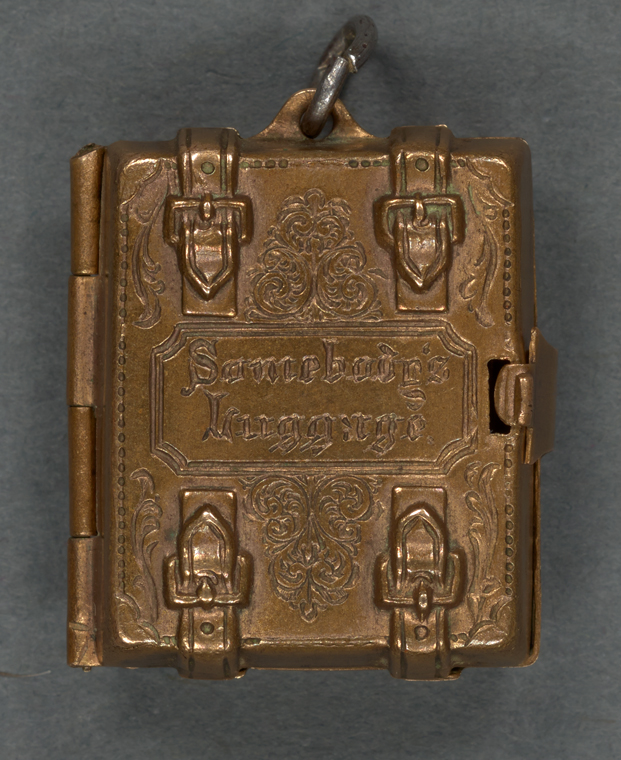Sharing Is Caring: A Photographic Locket of Mr. and Mrs. General Tom Thumb

Two years into an escalating Civil War, a divided nation paused to celebrate a joyful union. On February 10, 1863, Charles Sherwood Stratton (1838-1883), known popularly as General Tom Thumb, married Lavinia Warren (1841-1919) in Grace Episcopal Church in New York City. The entrepreneur P.T. Barnum employed these two little people in his cabinet of “human curiosities” at Barnum’s American Museum, where they sang and danced for admiring crowds. When he heard of their engagement in 1862, Barnum tirelessly promoted the wedding that became “the grand national event of the season” in the popular press.
“Grand” is perhaps an understatement for this so-called Fairy Wedding. Cartes de visite (small photographs pasted onto slightly larger cards) of the couple sold in the hundreds of thousands in the mid-1860s. Barnum pleaded with Tom Thumb to delay the wedding by a number of months in order to reap as many financial rewards from the huge public excitement as possible. On the wedding day, roads were blocked as thousands of onlookers waited outside the church on Broadway and 10th Street to witness the couple’s arrival in a miniature horse-drawn chariot, a gift from Queen Victoria. Barnum charged $75 per ticket (the equivalent of roughly $1,400 today) for the reception at the Metropolitan Hotel, which the Vanderbilts and Astors attended. President Lincoln regretted that he could not be present, but he sent Chinese screens as a wedding gift and held a reception honoring the couple during their honeymoon visit to D.C.
The Photography Collection has recently acquired a rare brass locket containing twelve miniature albumen prints of the famous couple made shortly after their wedding. The locket includes portraits by Mathew Brady and a popular image of Mrs. Thumb with a baby, one that was borrowed for the photo shoot to convey domestic success (she was in fact childless). The albumen prints are miniature, folding into the locket that measures only one inch on each side. Since jewelry bearing photographic portraits of loved ones was popular at the time, we can assume that this locket might actually have been worn. The locket itself is shaped like a suitcase and inscribed with “Somebody’s Luggage” on its front—likely a reference to the Charles Dickens story of that title about a waiter who publishes the stories he finds inside lost luggage, without knowing who wrote them. The extremely lightweight and portable format maximized the sharing potential of these celebrity images as it moved them into a physical proximity usually reserved for relatives, not strangers. The locket is one example of how photographs blurred the lines between familiar and unfamiliar, private and public as they gave innumerable afterlives to one-time events.
The Tom Thumb locket and other examples of memorabilia will be on view in Public Eye: 175 Years of Sharing Photography (December 12, 2014-September 5, 2015), in the Stephen A. Schwarzman Building’s Gottesman Exhibition Hall.
Further reading
Bluford Adams, E Pluribus Barnum: The Great Showman and the Making of U.S. Popular Culture. Minneapolis: University of Minnesota Press, 1997.
Phineas T. Barnum, Struggles and Triumphs, Or, Forty Years’ Recollection. Hartford: J.B. Burr, 1869.
Geoffrey Batchen, Forget Me Not: Photography and Remembrance. New York: Princeton Architectural Press, 2004.
James W. Cook, The Arts of Deception: Playing with Fraud in the Age of Barnum. Cambridge: Harvard University Press, 2001.
Elizabeth Siegel, Galleries of Friendship and Fame: A History of Nineteenth-Century American Photograph Albums. New Haven: Yale University Press, 2010.
Read E-Books with SimplyE
 With your library card, it's easier than ever to choose from more than 300,000 e-books on SimplyE, The New York Public Library's free e-reader app. Gain access to digital resources for all ages, including e-books, audiobooks, databases, and more.
With your library card, it's easier than ever to choose from more than 300,000 e-books on SimplyE, The New York Public Library's free e-reader app. Gain access to digital resources for all ages, including e-books, audiobooks, databases, and more.
If you don’t have an NYPL library card, New York State residents can apply for a digital card online or through SimplyE (available on the App Store or Google Play).
Need more help? Read our guide to using SimplyE.


Comments
What a wonderful, interesting
Submitted by Mary B Mayland (not verified) on October 29, 2014 - 2:04pm